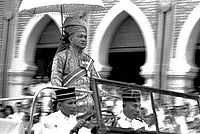Hari Kebangsaan Malaysia
Hari Kebangsaan Malaysia disambut di seluruh negara pada setiap 31 Ogos setiap tahun bagi menandakan negara bebas daripada belenggu penjajahan sejak 1511. Hari kebangsaan merupakan peristiwa utama dan disambut secara besar-besaran dengan mengadakan perarakan warna warni, konsert, pertunjukan pentas, pertandingan dan pelbagai lagi pertunjukan yang diadakan di tempat-tempat yang ditetapkan setiap tahun. Pada 31 Ogos, 2007, Malaysia telah menyambut ulangtahun hari kemerdekaan yang ke-50.
Kemeriahan Hari Kebangsaan dapat dirasakan bermula menjelangnya pukul 12.00 malam di mana bunga api yang berwarna-warni bergemerlapan di udara. Begitu juga acara perbarisan yang diwakili oleh pelbagai agensi turut diadakan bagi memeriahkan lagi suasana hari tersebut. Hari kebangsaan disambut paling meriah di Kuala Lumpur terutama di Dataran Merdeka.
Sambutan hari kebangsaan secara besar-besaran juga dibuat di Putrajaya. Bangunan- bangunan perniagaan, rumah kediaman dan kereta-kereta akan memasang dan mengibarkan bendera Malaysia, Jalur Gemilang, dan ini menyemarakkan lagi suasana perayaan. Hari kebangsaan merupakan hari cuti am di Malaysia.
| Tahun | Tema |
|---|---|
| 1970 | Muhibah dan Perpaduan |
| 1971 | Masyarakat Progresif |
| 1972 | Masyarakat Adil |
| 1973 | Masyarakat Kebudayaan Malaysia |
| 1974 | Sains dan Teknologi Alat Perpaduan |
| 1975 | Masyarakat Berdikari |
| 1976 | Ketahanan Rakyat |
| 1977 | 20 Tahun Bersatu Maju |
| 1978 | Kebudayaan Seni Perpaduan |
| 1979 | Bersatu Berdisiplin |
| 1980 | Berdisiplin Berbakti |
| 1981 | Berdisiplin Berharmoni |
| 1982 | Berdisiplin Giat Maju |
| 1983 | Bersama ke Arah Kemajuan |
| 1984 | Amanah Asas Kejayaan |
| 1985 | Nasionalisme Teras Perpaduan |
| 1986 | Bangsa Tegas Negara Teguh |
| 1987 | Setia Bersatu Berusaha Maju |
| 1988-1989 | Bersatu |
| 1990 | Berjaya |
| 1991 | Wawasan 2020 |
| 1992 | Wawasan Asas Kejayaan |
| 1993 | Bersatu Menuju Wawasan |
| 1994 | Nilai Murni Jayakan Wawasan |
| 1995 | Jatidiri Penggerak Wawasan |
| 1996 | Budaya Penentu Kecapaian |
| 1997 | Akhlak Mulia Masyarakat Berjaya |
| 1998 | Negara Kita Tanggungjawab Kita |
| 1999 | Bersatu Ke Alaf Baru |
| 2000-2006 | Keranamu Malaysia |
| 2007 | Malaysiaku Gemilang |
| 2008 | Perpaduan Teras Kejayaan |
| 2009 | 1Malaysia - Rakyat Didahulukan, Pencapaian Diutamakan |
| 2010 | 1Malaysia Menjana Tranformasi |
| 2011 | 1Malaysia. Transformasi Berjaya, Rakyat Sejahtera. |
| 2012 | 1Malaysia. Janji Ditepati[1] |


 Fig. 1. Linear Bus topology
Fig. 1. Linear Bus topology  Fig. 2. Star topology
Fig. 2. Star topology  Fig. 3. Tree topology
Fig. 3. Tree topology 















